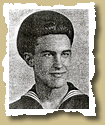| The Assault | Timeline | Maps | Men of D-Day | Photos |

|
I enlisted in the Navy in June of 1943 at the age of 17, and was part of the twelve-man LCT crew #5126 trained at Little Creek, Virginia on LCT(5) 443. We were shipped out of New York in March of 1944 on the troop transport Fredrick Lykes to Glasgow, Scotland. We travelled by train to the Royal Naval College at Darmouth, Devon, UK. We were split into two groups of six and assigned to LCTs already in training. I was one of the six assigned to the LCT(5) 539. We moved to various ports as amphibious training progressed--our final port was Plymouth, England, where we prepared for the Normandy invasion. We had, onboard, troops of the 16th Infantry of the 1st Division and the 37th Combat Engineers. Life on the night of 4 June, 1944 seemed quite normal as only a few of the troops were veterans of combat in Italy. The rest of us had no idea what to expect as we had never experienced combat. Referring to the logbook of the LCT-539, our skipper, Lt. (jg) Linwood Rideout ordered the engines started at 0300 the morning of 5 June. We had set a course for Normandy but we ordered to return to base due to the weather conditions. That night of 5 June, before the invasion, was very tense onboard as we had already embarked at about the same time the night before. On the morning of 6 June, 1944, we set course for the shores of Normandy, France. Referring to the logbook, the LCT-539 proceeded towards Easy Red, Omaha Beach, in the 8th wave with an escort of mine sweepers. At 0730 we hit the beach. As a gunner's mate, I was assigned to the port 20mm, with Howard Ledford as the loader, and Ira Tiller on the stern hook. We were under intense fire from the bluffs above the beach and suffered numerous hits from 47mm and 88mm projectiles. Our log entry states: "It being well guarded received two shells from 88mm. One in starboard locker, one in skipper's quarters. One 47mm hole in starboard bulwark. Two soldiers killed, two badly hurt. One 47mm thru port ramp extension." We were fortunate that all
of the hits we took were armor-piercing (AP) and not high explosive
projectiles. The ship log goes on to describe the situation that
morning at Omaha Beach: After we landed and disembarked the troops, time was spent hosing down the deck of the blood of those killed. It was a terrible experience. We then loaded wounded from the beach-a Navy cameraman was taking pictures of us carrying stretchers but I have never been able to locate them. We also took on a couple of wounded German prisoners, both sixteen years old, and proceeded to the Sam Chase to deposit both the dead and wounded. Dick Rung, a motor mechanic on the 539, had the opportunity to return to Normandy for the 50th anniversary. He viewed the beach from the bluff overlooking Easy Red and later remarked to me that it was a wonder any of us survived. In a letter to me, he described that he was "scared to death out there." He also commented, "You remember the sounds of the infantrymen being hit. I will never forget the blood as we finally unloaded and washed down the deck." Referring again to our logbook, we had casualties of two soldiers killed and two wounded. Our XO Ensign Slager was also wounded but it was never logged in. He came onboard shortly before we left England and was evacuated the day of the invasion so we never became acquainted. After all these years I can still hear what sounded like grunting noises made by the men who were hit. One of the soldiers who was killed was hit in the head-which literally exploded-parts of his skull and brain making a pink shower in the air that covered us. It was a horrible experience I shall never forget. On the next day, June 7, we had the opportunity to spend time on the beach. I remember the rows of dead and actual piles of arms and legs with no other remains. There were some casualties still on stretchers that had drowned when the tide came back in. There were so many casualties that on one of our later beachings, we pinned a British Soldier who must have floated from the British sector. We had to secure his body with a line until he could be retrieved when the tide came back in and allowed us to refloat. We spent the next few months transporting troops, supplies and vehicles from supply ships to shore and remember in the quiet evenings the sound of the large shells making a "swishing" sound as they passed over our heads when the ships fired at targets inland. I also remember the obsolete ships being scuttled to provide a breakwater harbour, and concrete units floated from England to provide further breakwater protection. The LCT-539 was craned onboard
the LST-309 for its return to the States. After overhaul, she was
transported to the Pacific theatre atop the LST-309. We were in
Leyte Gulf, still atop the 309, when the Japanese surrendered. As
part of the LST compliment, we transported occupation troops to
Otaru, Japan. Today, I keep in touch with
several of the former crew of the LCT-539 including Dick Rung (MoMM
3/c); Chet Rutkowski (MoMM 3/c); Millard Sipes ( MoMM 2/c); and
our Normandy skipper, Mr Rideout. I also keep in touch with Mr Larry
Bondi, XO of the LCT-546 at Normandy who later became the skipper
of the 539 in the Pacific.
|
| |
